2. 成都地质矿产研究所,成都 610082
2. Chengdu Institute of Geology and Mineral Resources, Chengdu 610082, China
三江特提斯复合造山带是全球特提斯构造在中国大陆最典型的发育地区(图 1a),也是我国最重要的多金属富集区(邓军等,2010)。作为吸收印-亚大陆碰撞应变的构造调节带(Dewey et al.,1988),三江数个构造剪切带内发育了一系列金矿床,以哀牢山金矿带和甘孜-理塘金矿带为代表。形成于新生代印-亚大陆晚碰撞阶段(侯增谦等,2008)的哀牢山金矿带主要发育有镇沅(老王寨)和大坪金矿床,其中镇沅蚀变岩型金矿产于受破碎带控制的煌斑岩脉、基性火山岩、超基性岩、酸性斑岩的蚀变带;大坪金矿为发育在闪长岩体中构造裂隙里的石英脉型金矿(熊德信等,2007)。金沙江-哀牢山缝合带内蛇绿混杂岩套是良好的矿源层(毕献武,1998),大坪金矿的赋矿围岩闪长岩也提供了部分成矿物质(俞广钧,1990),除此之外,哀牢山金矿带还具有其典型的地幔脱气特征,为金成矿提供了重要的成矿流体和成矿物质来源(毕献武,1998)。但关于成矿流体中水的来源争议颇大:一种观点认为来自大气降水(李定谋等,1998);还有一种观点认为是岩浆水(燕山期或喜马拉雅期中酸性侵入岩)或深源流体为主,有大量大气降水的混入(毕献武等,1997;胡瑞忠等,1999);毕献武(1998) 则认为成矿流体为深源流体(地幔去气)和大气降水的混合;也有观点认为有变质热液的成分(熊德信等,2007)。甘孜-理塘缝合带在新生代有着与金沙江-哀牢山缝合带类似的构造演化背景,但其地处三江特提斯最东缘,成矿特点有别于哀牢山金矿带。主要分布金矿床有嘎拉、雄龙西和阿加隆洼,此外还有色卡、尼亚达柯、错阿、尼多、阿达隆、宰乌隆洼等金矿点。嘎拉由燕山期形成的嘎拉韧性剪切带控制(戴宗明等,2003①),雄龙西和阿加隆洼则由新生代构造破碎带控制(于远山等,2001>②),均以微细浸染状黄铁矿化、毒砂化(辉锑矿化)糜棱岩型、 碎裂岩型矿石为主(晏子贵,2006; 邹光富和毛英,2007;杨永鹏和杨露云,2007;朱华平,2007)。前人研究表明甘孜-理塘缝合带内的微细浸染型金矿成矿流体来自大气降水,成矿物质源于围岩上三叠统曲嘎寺组蛇绿混杂岩套(张能德等,1998;付小方和应汉龙,2003;夏廷高,2006;邹光富和毛英,2007),但典型矿床的系统矿床成因研究仍比较缺乏。本文以阿加隆洼金矿床为典型剖析对象,探索其金成矿特征及成因,对于全面阐释特提斯演化过程中板块缝合带内的金成矿作用有重要意义。
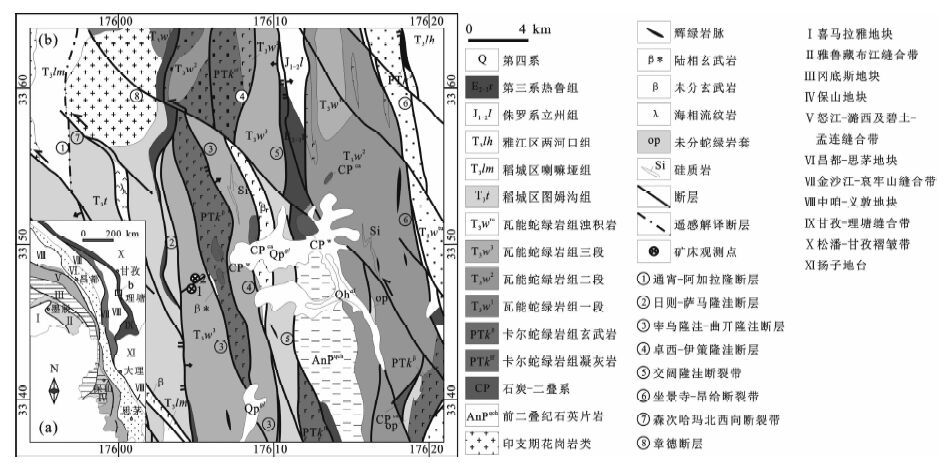
|
图 1 阿加隆洼金矿床地质图(a,据彭兴阶等,2002;b,据于远山等,2001;杨永鹏和杨露云,2007) Fig. 1 Geological map of Ajialongwa gold deposit(a,after Peng et al.,2002; b,after Yang and Yang,2007) |
① 戴宗明,秦华忠,侯浩等. 2003. 1∶25万新龙县幅区域地质调查报告(H47C002003). 成都: 四川省地质调查院
② 于远山,戴宗明,游再平等. 2001. 1∶25万甘孜县幅区域地质调查报告(H47C001003). 成都: 四川省地质调查院
1 区域地质和矿床地质甘孜-理塘缝合带紧邻松潘-甘孜褶皱带西南缘,西接义敦岛弧,由古特提斯洋之一——甘孜-理塘洋发展而成。甘孜-理塘洋于晚二叠世末扩张形成;晚三叠世中期(238~210Ma)洋壳由E向W/SW俯冲消减形成义敦岛弧火成岩带;晚三叠世末-燕山早期,义敦岛弧与扬子西缘发生近EW向碰撞(208~138Ma);白垩纪(138~75Ma)主要在义敦岛弧弧后区发生后造山伸展垮塌作用,缝合带伸展作用不明显;随后喜马拉雅早期,印度板块与欧亚大陆碰撞,晚阶段三江地区NW向走滑剪切导致第三纪地层强烈褶皱隆升(潘桂棠等,1997;侯增谦等,2001;魏永峰和罗森林,2004)。缝合带内发育早期裂谷环境形成的卡尔蛇绿岩组和晚期洋脊-洋岛过渡环境形成的瓦能蛇绿岩组,以及岩屑石英杂砂岩,长石石英杂砂岩,大理岩,结晶灰岩,白云母石英片岩等5类外来岩块,它们呈构造岩块接触,构成晚三叠统曲嘎寺组蛇绿混杂岩(T3q;邹光富,1995;魏永峰和罗森林,2004)。
阿加隆洼金矿床位于甘孜-理塘缝合带中段南端,地处理塘县西北部的禾尼乡,距离县城约58km,夹于近NS向的日则-萨马隆洼和宰乌隆洼-曲开隆洼深大断裂之间(图 1b)。截止2005年底,探明保有资源矿石量217×104t,金金属量6.7t(肖军等,2008)。赋矿围岩为隶属于上三叠统曲嘎寺组(邹光富,1995;潘桂棠等,1997)的瓦能蛇绿岩组三段(T3w3)变基性火山岩、凝灰质粉砂岩、岩屑砂板岩及炭质板岩,日则-萨马隆洼深大断裂以东发育的NE向阿加隆洼次级剪切破碎带容矿。这些构造破碎带形成于喜山期(于远山等,2001),可能对应印-亚大陆晚碰撞阶段(40~26Ma)大规模地壳缩短与相伴的强烈褶皱(Hou and Cook,2009),而在中生代地层内形成的大量层间断层和破碎带(侯增谦等,2008)。矿体呈串珠、透镜状,总体NEE走向(图 2),但局部受NW向破碎带控制,破碎带内见矿化期石英脉出露,石英脉呈膨大收缩脉状(图 3a)或透镜体(图 3b),反映于张性环境贯入。矿石碎裂结构常见(图 3c),常穿插有矿化石英和碳酸盐细脉(图 3d,e)。矿化以浸染状为主(图 3f),兼细脉状(图 3e)。矿石矿物主要有毒砂和黄铁矿,其次含闪锌矿和微量黄铜矿,氧化矿物褐铁矿常见。脉石矿物石英、(铁)白云石、方解石、绢云母最普遍。早期成岩黄铁矿常见粗粒自形-半自形碎裂、揉皱结构,或被矿化期毒砂围绕或嵌入其生长(图 3g);矿化期黄铁矿则多自形-他形微细浸染状分布(图 3f)。闪锌矿顺层(图 3h)或浸染状产出,系早期成岩产物;只少量于矿化期发育,与黄铜矿呈固溶体分离结构(图 3i)。矿化蚀变以硅化和碳酸盐化为主,表现为热液石英和碳酸盐矿物呈细脉产出,或以微细粒面状交代围岩,其次有绢云母化。
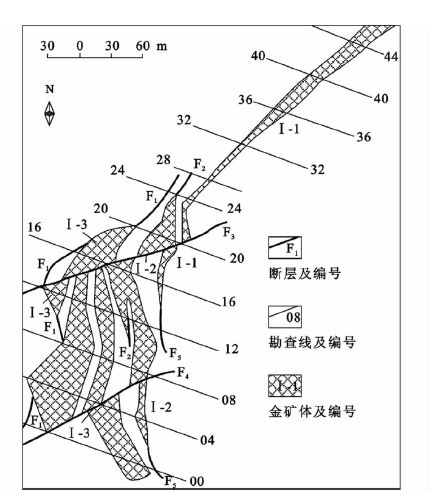
|
图 2 阿加隆洼金矿床矿体Ⅰ平面图(据杨伟寿等,2007) Fig. 2 Planar graph for ore bodyⅠof Ajialongwa gold deposit(after Yang et al.,2007) |
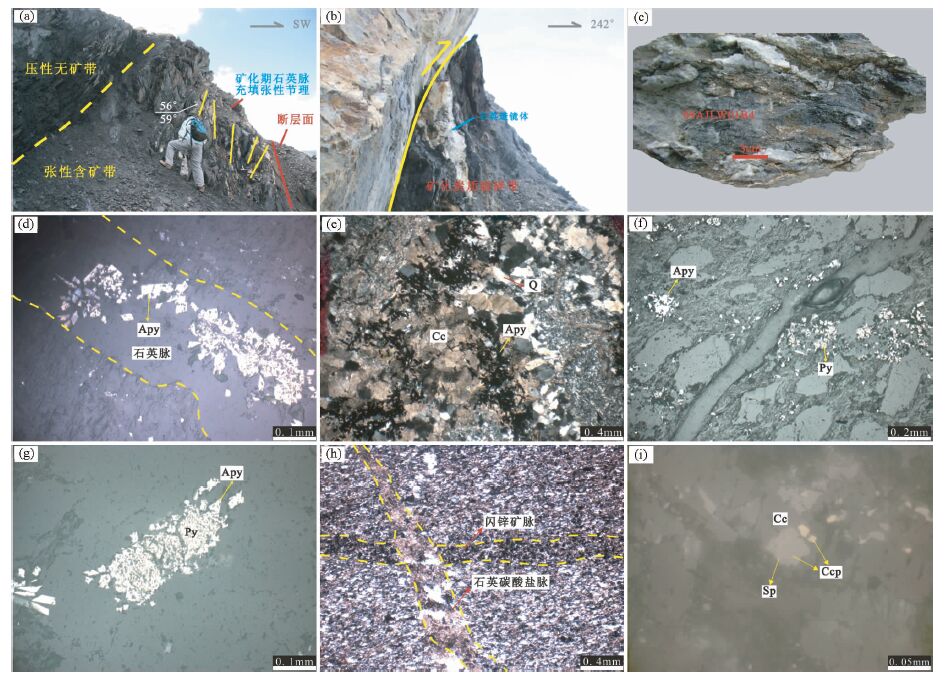
|
图 3 阿加隆洼金矿床地质特征 (a、b)-NW向矿化破碎带;(c)-碎裂岩型矿石;(d)-矿化石英细脉,反单偏光;(e)-与石英碳酸盐脉共生的毒砂矿脉,透正交偏光;(f)-浸染状分布的毒砂和黄铁矿,反单偏光;(g)-矿化期毒砂围绕破碎成岩黄铁矿生长,反单偏光;(h)-早期顺层闪锌矿脉被后期石英碳酸盐脉切错,透正交偏光;(i)-闪锌矿和黄铜矿固溶体,与碳酸盐化关系密切,反单偏光.Apy-毒砂;Py-黄铁矿;Sp-闪锌矿;Ccp-黄铜矿;Q-石英;Cc-方解石 Fig. 3 Geological characteristics of Ajialongwa gold deposit (a,b)-NW-trend mineralized fracture zone;(c)-cataclastic ore rock;(d)-small mineralized quartz vein in reflected and linearly polarized light;(e)-arsenopyrites vein coexisting with quartz-carbonate vein under transmitted and crossed polarized light;(f)-disseminated arsenopyrites and pyrites in reflected and linearly polarized light;(g)-diagenesis pyrite was surrounded by arsenopyrites of mineralization period,under reflected and linearly polarized light;(h)-later quartz-carbonate vein cutted across diagenesis sphalerite vein along the strata,under transmitted and crossed polarized light;(i)-sphalerite-chalcopyrite solid solution related to carbonatization in reflected and linearly polarized light. Apy-arsenopyrite; Py-pyrite; Sp-sphalerite; Ccp-chalcopyrite; Q-quartz; Cc-calcite |
供全岩及黄铁矿测试分析的矿石样品8件,矿石里含矿化期毒砂和黄铁矿以及少量成岩硫化物,围岩样品2件,发育成岩硫化物。全岩微量分析7件,其中2件围岩;硫化物硫铅同位素组成分析各9件,分别包括1件毒砂和9件黄铁矿,其中2件为围岩里挑出的成岩黄铁矿。显微测温样品矿化期产物5件,镜下均能观测到微量硫化物。其中01B2和01B3为图 3a中矿化破碎带里顺片理产出的石英脉;01B7和01B8分别为图 3b中矿化破碎带中的团块石英和透镜体石英;02B2为矿化碳酸盐细脉,含微量石英。供包裹体气液成分及稳定同位素分析的石英单矿物样品8件,除供显微测温前4件,还有矿化石英细脉01B11和01B16,以及与矿化有关的硅化团块01B17和01B21。具体测试样品见各分析结果表。
2.2 分析方法本文对矿石和围岩进行了微量元素分析,对其中的硫化物进行了硫铅同位素组成分析,对矿化期石英和方解石进行了包裹体显微测温以及气相成分和稳定同位素的测试。
全岩微量元素分析由中国地质科学院地球物理地球化学勘探研究所中心实验室完成。Au的测试方法为无火焰原子吸收光谱法(AAN),检出限为0.2×10-9;Ag、B的测试方法为发射光谱法(ES),检出限Ag为20×10-9,B为2×10-6;As的测试方法为原子荧光光谱法(AFS),检出限为1×10-6;S的测试方法为压片法X-射线荧光光谱法(XRF),检出限为50×10-6;其余微量元素的测试方法为等离子体质谱法(ICP-MS),检出限Hg为2×10-9,Sb、Bi为0.05×10-6,Te为0.01×10-6,W、Mo为0.2×10-6,Pb、Zn为2×10-6,Cu、La、Ce、Y为1×10-6,Tl及其余稀土元素为0.1×10-6。矿床产在甘孜-理塘缝合带,为典型的造山褶皱带,与矿化相关的元素用褶皱区地壳(据据黎彤和饶纪龙,1965;转黎彤和倪守斌,1990)进行标准化。稀土元素组成则用CⅠ球粒陨石平均值(Taylor and Mclennan,1985)进行标准化。
包裹体显微测温在中国地质大学(北京)地球科学与资源学院矿床教研室的流体包裹体实验室完成,所用仪器为英国生产的LINKAM THMSG600型冷热台,测温精度±0.1℃。流体包裹体的盐度值由冰点温度换算,所用公式如下(据Hall et al.,1988;转卢焕章等,2004):

|
(1) |
其中W为NaCl的重量百分比,Tm为冰点下降温度(℃)。利用Bischoff(1991) 的温度-密度相图及均一方式,可以确定流体密度(ρ),根据包裹体的均一温度(Th)在相应盐度的NaCl-H2O体系等容线温度-压力图解上估算出包裹体的捕获压力(P)(卢焕章等,2004)。
包裹体气相成分分析由中国科学院地质与地球物理研究所流体包裹体实验室朱和平完成,使用仪器为瑞士安维公司生产的QMS200型四极质谱仪,仪器重复测定精度<5%。
稳定同位素测试分析由中国科学院地质与地球物理研究所稳定同位素地球化学实验室完成,使用仪器氢氧同位素为质谱计MAT-252,硫同位素为质谱计Delta-S。测试对象氢同位素组成(δD)为石英包裹体,可直接代表流体的氢同位素组成;氧同位素组成(δ18O)为石英,须用公式(2) (据Blatter,1975;转郑永飞,1987)换算流体的氧同位素组成(δ18O水);硫同位素组成(δ34S)为硫化物,阿加隆洼金矿床中矿物组合简单且缺乏硫酸盐矿物,δ34S可大致代表热液的总硫同位素组成(δ34S∑;Ohmoto,1972)。δD为相对于国际标准V-SMOW之值,误差范围≤0.026‰;δ18O为相对于国际标准SMOW之值,误差范围≤0.021‰;δ34S为相对国际标准CDT之值,误差范围≤0.009‰。

|
(2) |
其中T为均一温度平均值(K),适用范围为T=100~200℃,部分样品无法进行流体包裹体测温,据可测样品得出的均一温度,假定平均均一温度为170.0℃。
铅同位素测试分析由中国地质科学院完成,测试方法为多接收器等离子体质谱法(MC-ICP-MAS)。测试对象为矿石和围岩中的硫化物。误差范围206Pb/204Pb为2σ≤0.0017,207Pb/204Pb为2σ≤0.0015,208Pb/204Pb为2σ≤0.0039。
3 测试结果 3.1 微量元素阿加隆洼金矿床矿石和围岩的微量元素组成(表 1)及微量元素蛛网图(图 4)显示矿化元素组合为Au、As、Sb、W、B、Hg,矿石和围岩的稀土元素组成显示出很好的一致性,稀土配分曲线微右倾,Eu显示微弱负异常(图 5)。矿石中黄铁矿高的As含量指示矿化期黄铁矿为含砷黄铁矿。
|
|
表 1 阿加隆洼金矿床矿石和围岩微量元素丰度(×10-6)及特征参数 Table 1 Trace elements abundance(×10-6)and parameters of host/ore rocks from Ajialongwa gold deposit |

|
图 4 阿加隆洼金矿床矿石和围岩微量元素蛛网图 Fig. 4 Fold zone crust normalized trace element patterns of ore/host rocks from Ajialongwa gold deposit |
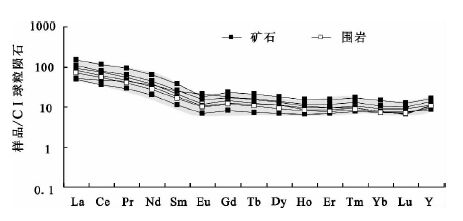
|
图 5 阿加隆洼金矿床矿石和围岩稀土配分曲线 Fig. 5 Chondrite normalized rare earth element patterns of ore/host rocks and pyrites from Ajialongwa gold deposit |
阿加隆洼金矿床矿化期石英和方解石中仅发育NaCl-H2O体系的水溶液包裹体,多为单相,形态多为椭圆形或不规则形。少数可测原生气液两相包裹体呈孤立或簇状产出,大小约2~6μm,气液体积比多在5%~10%,加热后均一到液相。包裹体均一温度(Th)样品01B2介于135~205℃,平均160.8℃;01B3介于120~205℃,平均154.1℃;01B7介于125~180℃,平均154.7℃;01B8介于145~215℃,平均169.4℃;02B2介于120~165℃,平均140.3℃(图 6)。盐度较低,介于0.18%~6.16% NaCleqv,并大致呈现2个峰值(图 7),流体密度(ρ)为0.859~0.968g·cm-3,包裹体捕获压力(P)介于2.21~19.62bar(1bar=105Pa)。
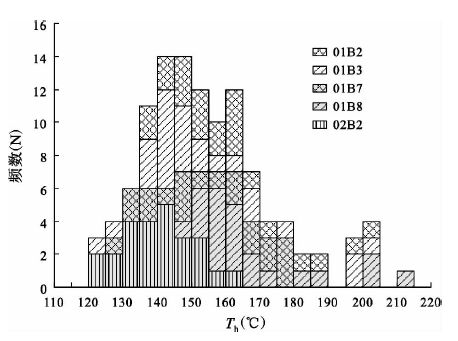
|
图 6 阿加隆洼金矿床均一温度直方图 Fig. 6 Histogram of homogeneous temperature of Ajialongwa gold deposit |
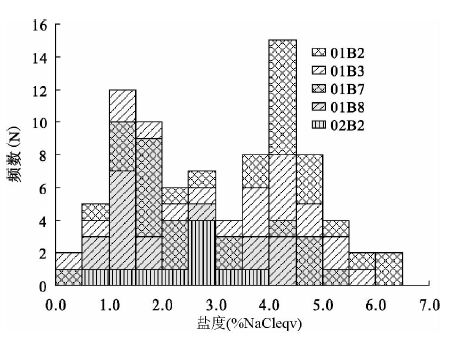
|
图 7 阿加隆洼金矿床成矿流体盐度直方图 Fig. 7 Histogram of ore-forming fluids’ salinity of Ajialongwa gold deposit |
阿加隆洼金矿床矿化期石英包裹体气相成分以H2O为主,占91.80mol%~97.63mol%,其次为CO2,占2.015mol%~7.297mol%,含少量N2、Ar和有机气体CH4、C2H6,极少量H2S,O2含量未达到检出限(表 2)。数据点全部落在Norman and Moore(1999) 给出的大气降水范围内(图 8)。成矿流体的还原参数不大,介于0.087~0.230。
|
|
表 2 阿加隆洼金矿床石英流体包裹体气相成分(mol%) Table 2 The gas phase composition of fluid inclusions in quartzes from Ajialongwa gold deposit(mol%) |
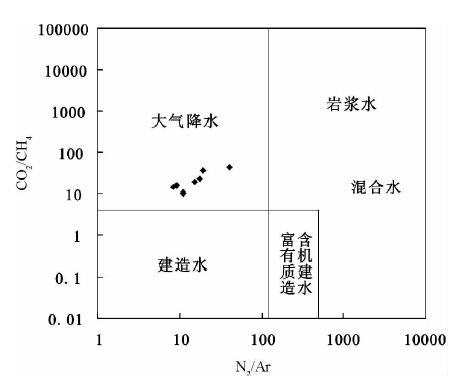
|
图 8 阿加隆洼金矿床成矿流体CO2/CH4-N2/Ar体系图(底图据Norman and Moore,1999;转孙晓明等,2004) Fig. 8 Diagram of CO2/CH4-N2/Ar of ore-forming fluids from Ajialongwa gold deposit(basic map after Norman and Moore,1999; from Sun et al.,2004) |
阿加隆洼金矿床氢氧同位素组成见表 3和图 9。成矿流体δD介于-124.243‰~ -114.968‰,δ18O水介于-1.56‰~1.91‰。矿石与围岩中的硫化物硫铅同位素组成具有很好的一致性:δ34S介于-13.249‰~-8.091‰;206Pb/204Pb介于18.406~18.611,207Pb/204Pb介于15.693~15.795,208Pb/204Pb介于38.837~39.528,靠近Zartman图解的上地壳增长曲线(表 4、图 10)。
|
|
表 3 阿加隆洼金矿床石英流体包裹体的稳定同位素组成 Table 3 The stable isotope composition of fluid inclusions in quartzs from Ajialongwa gold deposit |
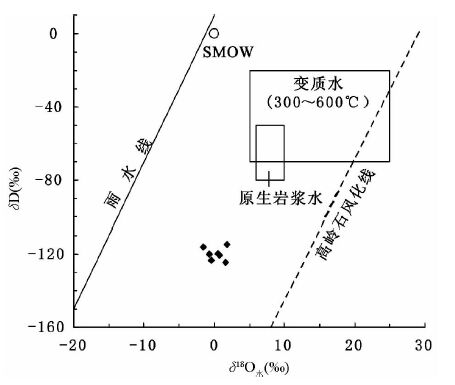
|
图 9 阿加隆洼金矿床成矿流体δ18O -δD协变图(底图据肖荣阁等,2008) Fig. 9 The δ18O and δD values of fluid inclusions from Ajialongwa gold deposit(after Xiao et al.,2008) |
|
|
表 4 阿加隆洼金矿床硫化物硫铅同位素组成 Table 4 Sulfur and lead isotope compositions of sulfides from Ajialongwa gold deposit |
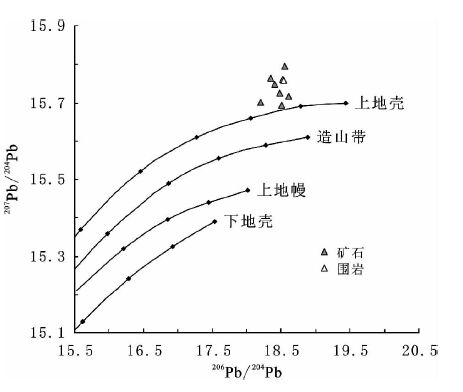
|
图 10 阿加隆洼金矿床硫化物Zartman图解(底图据Zartman and Doe,1981) Fig. 10 Pb isotope composition of sulfides from Ajialongwa gold deposit(after Zartman and Doe,1981) |
阿加隆洼金矿床中矿石比围岩中的Au含量高,相应地As、Sb、W、B、Hg也较围岩富集;矿石和围岩的稀土元素组成具有很好的一致性,稀土配分曲线微右倾,Eu显示微弱负异常;矿石和围岩硫化物的δ34S具有较大负值,介于-13.249‰~-8.091‰,显示很好的一致性;矿石和围岩硫化物的铅同位素组成靠近Zartman图解的上地壳增长曲线,两者也显示很好的一致性。以上表明流体萃取了围岩中的硫铅及其他成矿元素。
源自岩浆直接释放的硫或从岩浆硫化物中淋滤出来的硫,δ34S约0‰±0.5‰;来自海水和海相蒸发岩的硫,δ34S约20‰(Rye and Ohmoto,1974);源自围岩的硫,δ34S因还原机制不同而异(Ohmoto and Rye,1979),δ34S出现较大负值的矿床,硫来源与开放沉积条件下的有机(细菌)还原成因硫有关(Schwarcz and Burnie,1973),如沉积地层δ34S=-50‰~10‰,平均-25‰(Ohmoto et al.,1990)。阿加隆洼金矿床的δ34S介于-13.249‰~-8.091‰,不可能源自岩浆或岩浆硫化物以及海相蒸发岩,矿石和围岩一致,显示矿石硫继承了赋矿围岩曲嘎寺组蛇绿混杂岩中的硫。
4.2 成矿流体阿加隆洼金矿床仅发育NaCl-H2O体系的水溶液包裹体,成矿流体包裹体气液体积比恒定且小于10%,气相成分分析结果也显示CO2含量不高,仅介于2.015mol%~7.297mol%,Th=120~215℃,盐度介于0.18%~6.16% NaCleqv。以上显示成矿流体不具备高温浆控热液高温、高盐度、含石盐子晶包裹体的特征,也不同于岩浆来源的浅成低温热液由于沸腾作用包裹体气液体积比变化较大(陈衍景等,2007)。此外,缝合带内仅靠近西侧边界断裂的局部地区发育隶属于义敦岛弧的印支俯冲期花岗岩类(图 1),赋矿围岩上三叠统曲嘎寺组蛇绿混杂岩也出露岩浆岩,但这些岩体的侵位时间远远早于控制阿加隆洼金矿床的阿加隆洼次级剪切破碎带的形成时代喜山期,也就远远早于与破碎带同时或稍晚就位的阿加隆洼金矿床形成时间。综上,阿加隆洼金矿床的成矿流体不可能源于岩浆期后热液。变质热液(陈衍景等,2007;张静等,2004,2007,2008)和幔源流体(Deng et al.,2002,2003)富CO2,也不可能参与成矿。氢氧同位素组成(δD=-124.243‰ ~-114.968‰,δ18O水=-1.56‰~1.91‰)及包裹体气相成分(H2O含量91.80mol%~97.63mol%,CO2含量2.015mol%~7.297mol%)均显示成矿流体为循环后的大气降水(张静等,2005)。δD和δ18O水值变化范围窄,说明水-岩反应强度不大,未参与过深部循环。
4.3 成矿物理化学条件成矿流体的包裹体均一温度介于120~215℃,属低温成矿;盐度介于0.18%~6.16% NaCleqv,属低盐度范围;还原参数为0.087~0.230,表明介质的弱还原性;包裹体捕获压力2.21~19.62bar,如此低的捕获压力加之矿化发生在深大断裂日则-萨马隆洼剪切带以东的阿加隆洼次级剪切破碎带,指示剪切带成矿系统(邓军等,1998,1999)中的浅成张性环境成矿。
4.4 成矿时代张能德等(1998) 用K-Ar和Rb-Sr法对嘎拉金矿床作了同位素年代学研究,其中K-Ar年龄为177~149Ma,矿石Rb-Sr等时线年龄157±14Ma。晏子贵(2006) 认为甘孜-理塘金矿带的金成矿作用与燕山-喜山期强烈的逆冲挤压造山作用(包括碰撞造山及其后的陆内汇聚)关系密切。朱华平(2007) 则认为,阿加隆洼金矿床在晚二叠世-中三叠世形成蛇绿岩套初始矿源层的基础上,晚三叠世末板块俯冲及弧-陆碰撞作用发生了金的初始富集形成构造蚀变岩,侏罗-白垩纪甘孜-理塘碰撞造山带转入陆内汇聚阶段,表现为金-毒砂-黄铁矿-石英脉沿着张性及张扭性破裂面发育,造成金的局部再富集成矿。杨伟寿等(2007) 也认为晚三叠世末到侏罗纪-白垩纪,碰撞造山作用使得矿源层发生过初始富集,矿床的最终定位则发生于古近纪陆内汇聚时期。鉴于控制阿加隆洼金矿床的阿加隆洼剪切破碎带为走滑时期的压性-压扭性产物(于远山等,2001),喜山期NW向陆内汇聚剪切作用(侯增谦等,2008)作为驱动力才便于形成这种NE向剪切破碎带,金矿床就位至少应该同时或稍晚于该破碎带的形成时间,本文推断其为喜山期成矿。
4.5 矿床类型与哀牢山金矿带不同,阿加隆洼金矿床成矿过程中没有地幔物质的涌入。阿加隆洼金矿床赋矿围岩蛇绿混杂岩虽为构造岩块接触,但同属沉积岩系;矿石矿物黄铁矿、毒砂等呈微细浸染状分布;矿化蚀变以硅化和碳酸盐化为主;矿化元素组合为Au、As、Sb、W、B和Hg;成矿物质来自围岩,成矿流体为循环后的大气降水;于剪切破碎带的张性环境聚集沉淀,形成低温低盐度低CO2的碎裂岩型金矿。以上特征均与类卡林型金矿床(Hofstra and Cline,2000; Emsbo et al.,1999,2003,2006; Emsbo and Hofstra,2003)相符,而有别于中高温富CO2石英脉型造山型金矿(Kerrich et al.,2000)。
5 结论形成于甘孜-理塘缝合带内的阿加隆洼金矿床,赋矿围岩为上三叠统曲嘎寺组蛇绿混杂岩中的瓦能蛇绿岩组,由区域深大断裂日则-萨马隆洼断层的喜山期次级剪切破碎带阿加隆洼断裂容矿。矿石矿物以毒砂和含砷黄铁矿为主,呈微细浸染状分布;脉石矿物有石英、碳酸盐矿物、绢云母等;矿化蚀变主要是硅化和碳酸盐化;矿化元素组合为Au、As、Sb、W、B、Hg。成矿物质来自围岩,成矿流体为浅部循环后的大气降水。此外,成矿流体低温(120~215℃)低盐度(0.18%~6.16% NaCleqv)低CO2含量(2.015mol%~7.297mol%),且具弱还原性(0.087~0.230),包裹体捕获压力小(2.21~19.62bar)。各种证据显示阿加隆洼矿床为类卡林型,可能是三江地区新生代陆-陆碰撞背景下的产物。
致谢 野外工作得到袁万明教授的指导以及研究生郇伟静、李娜、马楠、赵凯和燕旎的协助,室内分析得益于与博士生肖昌浩、李龚建和周晓辉,研究生赵岩、康建丽和翟德高的讨论,在此一并表示感谢。| [] | Bi XW, Hu RZ and He MY. 1997. Characteristics of ore-forming fluid of three gold deposits in Ailaoshan gold mineralization belt. Acta Mineralogica Sinica , 17 (4) :435–441. |
| [] | Bi XW. 1998. The metallogenetic mechanism of Ailaoshan gold belt. Bulletin of Mineralogy, Petrology and Geochemistry , 17 (1) :16–19. |
| [] | Bischoff JL. 1991. Densities of liquids and vapors in boiling NaCl-H2O solutions: A PVTX summary from 300℃ to 500℃. America Journal Sciences , 291 :309–338. |
| [] | Blatter P. 1975. Oxygen isotope composition of fissure-grown quartz, adularia, and calcite from Broadlands geothermal field, New Zealand, with an appendix on quartz-K-feldspar-calcite-muscovite oxygen isotope geothermometers. American Journal of Science , 275 :785–850. DOI:10.2475/ajs.275.7.785 |
| [] | Chen YJ, Ni P, Fan HR, et al. 2007. Diagnostic fluid inclusions of different type hydrothermal gold deposits. Acta Petrologica Sinica , 23 (9) :2085–2092. |
| [] | Deng J, Zhai YS and Yang LQ. 1998. On ore-forming system of shear zone tectonics. Geoscience , 12 (4) :493–500. |
| [] | Deng J, Yang LQ, Sun ZS, et al. 1999. Dynamic machanism and model of ore-forming system of shear zone tectonics. Geoscience , 13 (2) :125–129. |
| [] | Deng J, Liu W, Sun ZS, et al. 2002. Evidence of mantle-rooted fluids and multi-level circulation ore-forming dynamics: A case study from the Xiadian gold deposit, Shandong Province, China. Science in China (Series D) , 46 (Suppl) :123–134. |
| [] | Deng J, Sun ZS, Wang QF, et al. 2003. Crust-mantle structures and gold enrichment mechanism of mantle fluid system. Chinese Journal of Geochemistry , 22 (3) :263–270. DOI:10.1007/BF02842870 |
| [] | Deng J, Hou ZQ, Mo XX, et al. 2010. Superimposed orogenesis and metallogenesis in Sanjiang Tethys. Mineral Deposits , 29 (1) :37–42. |
| [] | Dewey JF, Shackleton RM, Chang C et al. 1988. The Tectonic Evolution of the Tibetan Plateau. London: Philosophical Translations of the Royal Society |
| [] | Emsbo P, Hutchinson RW, Hofstra AH, et al. 1999. Syngenetic Au on the Carlin trend: Implications for Carlin-type deposits. Geology , 27 (1) :59–62. DOI:10.1130/0091-7613(1999)027<0059:SAOTCT>2.3.CO;2 |
| [] | Emsbo P and Hofstra AH. 2003. Origin and significance of post ore dissolution collapse breccias cemented with calcite and barite at the Meikle gold deposit, northern Carlin trend, Nevada. Economic Geology , 98 :1243–1252. |
| [] | Emsbo P, Hofstra AH, Lauha EA, et al. 2003. Origin of high-grade gold ore, source of ore fluid components, and genesis of the Meikle and neighboring Carlin-type deposits, northern Carlin Trend, Nevada. Economic Geology , 98 :1069–1105. DOI:10.2113/gsecongeo.98.6.1069 |
| [] | Emsbo P, Groves DI, Hofstra AH, et al. 2006. The giant Carlin gold province: A protracted interplay of orogenic, basinal, and hydrothermal processes above a lithospheric boundary. Mineralium Deposita , 41 :517–525. DOI:10.1007/s00126-006-0085-3 |
| [] | Fu XF and Ying HL. 2003. Cenozoic tectonic movement and its relationship with gold mineralization in the northern segment of the Garzê-Litang fault belt. Geology in China , 30 (4) :413–418. |
| [] | Hall DL, Sterner SM and Bodnar RJ. 1988. Freezing point depression of NaCl-KCl-H2O solutions. Economic Geology , 83 :197–202. DOI:10.2113/gsecongeo.83.1.197 |
| [] | Hofstra AH and Cline AJ. 2000. Characteristics and models for Carlin-type gold deposits. Reviews in Economic Geology , 13 :163–220. |
| [] | Hou ZQ, Qu XM, Zhou JR, et al. 2001. Collision-orogenic processes of the Yidun arc in the Sanjiang region: Record of granites. Acta Geologica Sinica , 75 (4) :484–497. |
| [] | Hou ZQ, Wang EQ, Mo XX, et al.2008. Coliision and Metallogeny of Tibetan Plateau. Beijing: Geological Publishing House . |
| [] | Hou ZQ and Cook NJ. 2009. Metallogenesis of the Tibetan collisional orogen: A review and introduction to the special issue. Ore Geology Review , 36 (1-3) :2–24. DOI:10.1016/j.oregeorev.2009.05.001 |
| [] | Hu RZ, Bi XW, Turner G, et al. 1999. Helium and argon isotopic geochemistry of ore-forming fluid from Ailaoshan ore belt. Science in China (Series D) , 29 (4) :321–330. |
| [] | Kerrich R, Goldfarb R, Groves D, et al. 2000. The charaeteristies, origins, and geodynamic settings of supergiant gold metallogenic provinces. Science in China (Series D) , 43 (Suppl) :1–68. |
| [] | Li DM, Cao ZM, Qin GJ, et al.1998. Gold Deposits in Ailaoshan Ophiolitic Mélange Zone. Beijing: Geological Publishing House . |
| [] | Li T and Yio CL. 1965. The abundance of chemical elements in the earth’s crust and its major tectonic units. Acta Geologica Sinica , 45 (1) :82–97. |
| [] | Li T and Ni SB.1990. The Abundance of Chemical Elements in the Earth and Crust. Beijing: Geological Publishing House . |
| [] | Lu HZ, Fan HR, Ni P, et al.2004. Fluid Inclusions. Beijing: Geological Publishing House . |
| [] | Norman DI and Moore JN. 1999. Methane and excess N2 and Ar in geothermal fluid inclusions. In: Proc. 24th Workshop Geotherm. Reservoir. Stanford: Stanford University, 196-202 |
| [] | Ohmoto H. 1972. Systematics of sulfur and carbon isotopes in hydrothermal ore deposits. Economic Geology , 67 (5) :551–578. DOI:10.2113/gsecongeo.67.5.551 |
| [] | Ohmoto H and Rye RO. 1979. Isotopes of sulfur and carbon. In: Barnes HL (ed.). Geochemistry of Hydrothermal Ore Deposits. New York: John Wiley & Sons, Inc., 509-567 |
| [] | Ohmoto H, Kaiser CJ and Geer KA. 1990. Systematics of sulphur isotopes in recent marine sediments and ancient sediment-hosted basemetal deposits. In: Herbert HK and Ho SE (eds.). Stable Isotopes and Fluid Processes in Mineralization. Perth: University of Western Austrilia Publication, 23: 70-120 |
| [] | Pan GT, Chen ZL, Li XZ, et al.1997. Geological-Tectonic Evolution in the Eastern Tethys. Beijing: Geological Publishing House . |
| [] | Peng XJ, Liu JH and Wu JH. 2002. Geology of Nujiang-Lancangjiang-Jinshajiang area. In: Editorial Committee of “Geological atlas of China” (ed.). Geological Atlas of China. Beijing: Geological Publishing House, 105-108 (in Chinese) |
| [] | Rye RO and Ohmoto H. 1974. Sulfur and carbon isotopes and ore genesis: A review. Economic Geology , 69 :826–842. DOI:10.2113/gsecongeo.69.6.826 |
| [] | Schwarcz HP and Burnie SW. 1973. Influence of sedimentary environments on sulfur isotope ratios in clastic rocks: A review. Mineralium Deposita , 8 :264–277. |
| [] | Sun XM, Wang M, Xue T, et al. 2004. New advance in research of trace gaseous compositions in fluid inclusions and their applications as indicators of ore-forming fluid sources and processes. Earth Science Frontiers , 11 (2) :471–478. |
| [] | Taylor SR and Mclennan SM.1985. The Continental Crust: Its Composition and Evolution. New York: Wiley-Heyden . |
| [] | Wei YF and Luo SL. 2004. Division and composition of the non-Smithian strata in the middle part of the Garze-Litang suture zone, western Sichuan. Sedimentary Geology and Tethyan Geology , 24 (4) :21–30. |
| [] | Xia TG. 2006. Research on metallogeny and prospecting models of Garzê-Litang gold ore belt, Sichuan Province. Ph. D. Dissertation. Chengdu: Chengdu University of Technology (in Chinese with English summary) |
| [] | Xiao J, Sun CM, Liu YS, et al. 2008. Wallrock alteration and relation with gold mineralization of Ajialongwa gold deposit in the central Ganzi-Litang fault zone, Sichuan. Geology and Prospecting , 44 (6) :8–12. |
| [] | Xiao RG, Liu JD, Fei HC, et al.2008. Geochemistry on Rock and Mineral Deposit. Beijing: Seismological Press . |
| [] | Xiong DX, Sun XM and Shi GY.2007. Geochemistry and Metallogenic Model of Ailaoshan Cenozoic Organic Gold Belt in Yunnan Province, China. Beijing: Geological Publishing House . |
| [] | Yan ZG. 2006. Geological characteristics of gold deposits in Ganzi-Litang fault zone and preliminary discussion on their ore controll factors. Conributions to Geology and Mineral Resources Research , 21 (Suppl) :52–57. |
| [] | Yang WS, Hu ZW and He DR. 2007. Geochemical model for mineral prospecting of the Ajialongwa gold deposit in the central segment of the Garzê-Litang fault zone in Sichuan. Geology in China , 34 (1) :123–131. |
| [] | Yang YP and Yang LY. 2007. Geological features and prospecting potential of the Ajialongwa-Yahuo Au-(Cu) ore zone, Litang, Sichuan. Acta Geologica Sichuan , 27 (3) :170–176. |
| [] | Yu GJ. 1990. Types and ore-controlling conditions of primary gold deposits in the Ailaoshan gold ore belt. Geology and Prospecting , 26 (5) :3–11. |
| [] | Zartman RE and Doe BR. 1981. Plumbotectonics-thermodel. Tectonophys , 75 :135–162. DOI:10.1016/0040-1951(81)90213-4 |
| [] | Zhang J, Chen YJ, Li GP, et al. 2004. Characteristics of ore geology and fluid inclusion of the Yindonggou silver deposit, Neixiang County, Henan Province: Implication for metallogenic type. Mineral. Petrol. , 24 (3) :55–64. |
| [] | Zhang J, Yan GP, Ye L, et al. 2005. The C-H-O isotope systematics of the Yindonggou Ag-dominated poly-metals deposit in the Neixiang County, Henan Province. Acta Petrologica Sinica , 21 (5) :1359–1364. |
| [] | Zhang J, Qi JP, Qiu JJ, et al. 2007. Compositional study on ore fluid of the Yindonggou silver deposit in Neixiang County, Henan Province, China. Acta Petrologica Sinica , 23 (9) :2217–2226. |
| [] | Zhang J, Yang Y, Lu YH, et al. 2008. Geological and geochemical characteristics and genesis of the Poshan silver deposit, Henan Province. Geology in China , 35 (6) :1220–1229. |
| [] | Zhang ND, Cao YW, Niao YA, et al.1998. Geology and Metallogeny in Garzê-Litang Rift Zone. Beijing: Geological Publishing House . |
| [] | Zheng YF. 1987. Stable isotope geothermometer. Northwestern Geology (2) :15–25. |
| [] | Zhu HP. 2007. Geological characteristics and genesis of Ajialongwa gold deposit, Sichuan Province. Gold , 28 (6) :18–20. |
| [] | Zou GF. 1995. Advance of the research on the Garze-Litang plate junction. Acta Geologica Sichuan , 15 (4) :257–263. |
| [] | Zou GF and Mao Y. 2007. Geologic characteristics and origin of Garze Gala gold deposit, Sichuan Province. Gold , 28 (5) :9–13. |
| [] | 毕献武, 胡瑞忠, 何明友.1997. 哀牢山金矿带主要金矿床成矿流体特征. 矿物学报 , 17 (4) :435–441. |
| [] | 毕献武.1998. 哀牢山金矿带金成矿制约机制探讨. 矿物岩石地球化学通报 , 17 (1) :16–19. |
| [] | 陈衍景, 倪培, 范宏瑞, 等.2007. 不同类型热液金矿系统的流体包裹体特征. 岩石学报 , 23 (9) :2085–2092. |
| [] | 邓军, 翟裕生, 杨立强.1998. 论剪切带构造成矿系统. 现代地质 , 12 (4) :493–500. |
| [] | 邓军, 杨立强, 孙忠实, 等.1999. 剪切带构造成矿动力机制与模式. 现代地质 , 13 (2) :125–129. |
| [] | 邓军, 侯增谦, 莫宣学, 等.2010. 三江特提斯复合造山与成矿作用. 矿床地质 , 29 (1) :37–42. |
| [] | 付小方, 应汉龙.2003. 甘孜-理塘断裂带北段新生代构造特征及金矿成矿作用. 中国地质 , 30 (4) :413–418. |
| [] | 侯增谦, 曲晓明, 周继荣, 等.2001. 三江地区义敦岛弧碰撞造山过程: 花岗岩记录. 地质学报 , 75 (4) :484–497. |
| [] | 侯增谦, 王二七, 莫宣学, 等. 2008. 青藏高原碰撞造山与成矿作用. 北京: 地质出版社 . |
| [] | 胡瑞忠, 毕献武, TurnerG, 等.1999. 哀牢山成矿带成矿流体的He和Ar同位素地球化学. 中国科学(D辑) , 29 (4) :321–330. |
| [] | 黎彤, 饶纪龙.1965. 论化学元素在地壳及其基本构造单元中的丰度. 地质学报 , 45 (1) :82–97. |
| [] | 黎彤, 倪守斌. 1990. 地球和地壳的化学元素丰度. 北京: 地质出版社 : 74 -76. |
| [] | 李定谋, 曹志敏, 覃功炯, 等. 1998. 哀牢山蛇绿混杂岩带金矿床. 北京: 地质出版社 . |
| [] | 卢焕章, 范宏瑞, 倪培, 等. 2004. 流体包裹体. 北京: 地质出版社 . |
| [] | 潘桂棠, 陈智梁, 李兴振, 等. 1997. 东特提斯地质构造形成演化. 北京: 地质出版社 . |
| [] | 彭兴阶, 刘嘉惠, 吴精汇. 2002. 怒江-澜沧江-金沙江地区地质. 见:《中国地质图集》编委会. 中国地质图集. 北京: 地质出版社, 105-108 |
| [] | 孙晓明, 王敏, 薛婷, 等.2004. 流体包裹体中微量气体组成及其成矿示踪体系研究新进展. 地学前缘 , 11 (2) :471–478. |
| [] | 魏永峰, 罗森林.2004. 甘孜-理塘结合带中段非史密斯地层的划分及组分特征. Sedimentary Geology and Tethyan Geology , 24 (4) :21–30. |
| [] | 夏廷高. 2006. 四川省甘孜-理塘金矿成矿带成矿模式与开发模式研究. 博士学位论文.成都: 成都理工大学 |
| [] | 肖军, 孙传敏, 刘严松, 等.2008. 四川甘孜-理塘断裂带中段阿加隆洼金矿围岩蚀变特征及与金矿化关系. 地质与勘探 , 44 (6) :8–12. |
| [] | 肖荣阁, 刘敬党, 费红彩, 等. 2008. 岩石矿床地球化学. 北京: 地质出版社 . |
| [] | 熊德信, 孙晓明, 石贵勇. 2007. 云南哀牢山喜马拉雅期造山型金矿带矿床地球化学及成矿模式. 北京: 地质出版社 . |
| [] | 晏子贵.2006. 甘孜-理塘断裂带金矿成矿地质特征和控矿因素浅析. 地质找矿论丛 , 21 (增刊) :52–57. |
| [] | 杨伟寿, 胡正文, 何德润.2007. 四川甘孜-理塘断裂带中段阿加隆洼金矿床地球化学找矿模式. 中国地质 , 34 (1) :123–131. |
| [] | 杨永鹏, 杨露云.2007. 四川理塘阿加隆洼-亚火金(铜)矿带地质特征及找矿前景. 四川地质学报 , 27 (3) :170–176. |
| [] | 俞广钧.1990. 哀牢山金矿带原生金矿床的类型及控矿. 地质与勘探 , 26 (5) :3–11. |
| [] | 张静, 陈衍景, 李国平, 等.2004. 河南内乡县银洞沟银矿地质和流体包裹体特征及成因类型. 矿物岩石 , 24 (3) :55–64. |
| [] | 张静, 燕光谱, 叶霖, 等.2005. 河南内乡县银洞沟银多金属矿床碳-氢-氧同位素地球化学. 岩石学报 , 21 (5) :1359–1364. |
| [] | 张静, 祁进平, 仇建军, 等.2007. 河南内乡县银洞沟银矿床流体成分研究. 岩石学报 , 23 (9) :2217–2226. |
| [] | 张静, 杨艳, 鲁颖怀, 等.2008. 河南破山银矿床地质地球化学特征及成因研究. 中国地质 , 35 (6) :1220–1229. |
| [] | 张能德, 曹亚文, 廖远安, 等. 1998. 四川甘孜-理塘裂谷带地质与成矿. 北京: 地质出版社 . |
| [] | 郑永飞.1987. 稳定同位素地质温度计. 西北地质 (2) :15–25. |
| [] | 朱华平.2007. 四川阿加隆洼金矿床的地质特征及矿床成因. 黄金 , 28 (6) :18–20. |
| [] | 邹光富.1995. 甘孜-理塘板块缝合带研究的新进展. 四川地质学报 , 15 (4) :257–263. |
| [] | 邹光富, 毛英.2007. 四川甘孜嘎拉金矿地质特征及矿床成因研究. 黄金 , 28 (5) :9–13. |
 2012, Vol. 28
2012, Vol. 28


